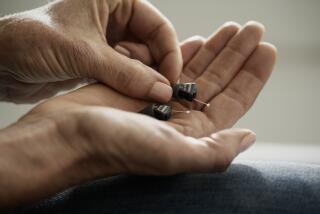Study Will Track Ear Implantsâ Effect on Job Potential for Deaf
Dorothy Falk gets an edge to her voice as she talks about the last job she had--the one she believes she lost a decade ago because her hearing was fading.
âI was foolishly too frank with them. I told them outright that I did have a hearing problem and was getting a hearing aid,â the Encinitas resident recalls.
But, shortly afterward, Falk was told that her five-year-long job as a receptionist at a decorating firm was being eliminated. As her hearing worsened over the ensuing decade, getting another job became out of the question.
Steve Bessen has a different story. Even though his hearing dwindled to virtually nothing during his last year in medical school at UC San Diego, he graduated in 1988 and is launching a career as a radiologist. He finished an internship last month in San Francisco, and is starting a residency in Arizona.
The differences in their experiences in the work world stem in part from the decade separating them, but another factor was the cochlear implant that Bessen could turn to when his hearing failed.
The device--no bigger than a quarter and connected to a small battery pack and computer processor worn like a pager--is implanted in the inner ear and bone behind the ear. It turns sound into electrical signals that stimulate the auditory nerve in the cochlea and give a profoundly deaf person what, so far, is the next best thing to full hearing.
Gathering Evidence
About 2,400 have been implanted into deaf people around the United States in the last several years.
That an invention such as this would make it easier for a deaf person to hold down a job and advance in a career might seem self-evident, and physicians abound with anecdotal evidence that this is the case, said Dr. Jeffrey P. Harris, chief of otolaryngology at UCSD Medical Center.
To gather firmer evidence, however, and perhaps to change vocational rehabilitation policy in California, Harris has launched a three-year study of the effect these high-tech devices have on the vocational possibilities for the deaf.
âWhether or not this will ultimately change their life is not known,â Harris said. âIt is clear that people like the implant. But itâs not clear that a group of patients will be able to go back on the employment ranks. It also is not clear that their median income is going to increase. It is suspected that will happen, but there is no way to prove it.â
The study Harris leads will give cochlear implants at no cost to 10 people anywhere in California who meet stringent requirements for hearing loss, various medical factors, and potential for re-entering the work force or improving their position in it. Harris is scheduled to perform the programâs first implant today at UCSD Medical Center. Then the researchers will watch to see if the patientsâ lives improve.
Harrisâ co-investigators are John P. Anderson and Charles C. Berry of UCSDâs Department of Community and Family Medicine.
Harris notes that a 1983 state study found that, contrasted with others with less serious hearing impairments, the severely to profoundly deaf in California had the lowest educational attainment level, lowest median family income and lowest rate of participation in the labor force. At $8,845, their median family income was just 41% of the average for the general population at the time.
âBeing deaf is an isolating problem for people,â Harris said. âThey canât interact in any reasonable way, and, as a consequence, it really affects their ability to maintain a job outside of their own environment. Their employer tells them to do something, and they donât hear it. The employer doesnât have the time to stand and write things out--they donât want to have to do that.â
Becoming More Acceptable
If a personâs annual income rose just $5,000 as a result of an implant, Harris noted, the $24,000 cost of implanting the device, adjusting it and teaching the patient to use it would be made up in just five years.
Cochlear implants are becoming more accepted by insurance companies as therapy for deaf people who cannot be helped by hearing aids, noted Dr. Fernando Tellez, chief medical consultant for state Department of Rehabilitation. Medicare, for example, paid for Falkâs implant, and medical insurance partly paid for Bessenâs.
However, Tellezâ department and Medi-Cal, the state medical program for the indigent, still do not pay for the implants.
As was the case both with Falk and Bessen, standard therapy for hearing impairment is to first use much less expensive technologies such as hearing aids. These generally cost less than $1,000 and merely amplify the diminished sound signals the damaged ear receives. However, when the nerves of the inner ear can no longer receive any useful sound signals at all, the more expensive cochlear implants are considered.
âNow medical technology has advanced to the point that the medical community offers an opportunity to overcome this problem through cochlear implant. It is relatively new but has been established, and we feel that itâs time that we try to make a determination to see exactly how this new technique will affect people on a vocational basis,â Tellez said.
The department, which directs the stateâs vocational assistance for the handicapped, is providing about $340,000 for the study. One of the implant devices also is being paid for by a donation from an Ear of the Lion club in the San Francisco Bay area, Harris said.
The study could provide the factual underpinning for changing state policy to pay for cochlear implants as a job rehabilitation measure for the most severely deaf, Tellez said.
Harris calls former UCSD medical student Bessen a âbeautiful example of a case where the cochlear implant probably is helping him go forward with his career, which otherwise would have ended.â
Harder and Harder
Bessen himself now feels he would have continued his career track by lip-reading without the implant, but he acknowledges that it was harder and harder for him to keep up in school as his hearing faded so much that a hearing aid was no help.
âI really was wondering if I would be able to graduate from medical school and do my internship,â he said in a phone interview, conducted via a Teletype machine and a relay operator. (Like many other cochlear implant recipients, he is delighted at being able to distinguish sounds so well that he can talk on the telephone, but he can do so only if the words are spoken by people with whose voice nuances he is familiar.)
Now, with lip-reading and the cochlear implant, Bessen says he is doing well. âI can actually lip-read without the implant, but having the sound there makes it much, much easier,â he said.
The implant in his left ear also has opened up a world of other sounds. âI am sure I hadnât heard any sound in that ear for over 20 years but now, one year later, I can really distinguish all kinds of environmental sounds, for example cars driving by, sirens, birds chirping,â he said.
At 67, Dorothy Falk has no plans to turn the cochlear implant she received in March into a tool for finding a job. But her delight at being able to distinguish sounds again, and even talk on the phone to her daughter, is unmistakable.
While Falk talks, her face takes on an animation that her daughter, Melody Creighton, says was rarely seen over the last two years as her motherâs hearing waned. Over about two decades previously, a hearing aid had helped, but by last winter her hearing had faded to nothing. Falk was very depressed, she and her daughter say.
âSix months ago there was this little woman just shriveling up. What you see now is a completely different person,â Creighton said.
âIt is like being brought back to life,â Falk says of her implant. âI had been so isolated, and now I can actually talk to people.â
Falk said she sees the implant as part of a wide range of less costly hearing-assistance devices that far too many people never find.
âI can spot people that are having trouble hearing. I just want to help them because I know exactly what they are going through. It frustrates me to know that there are things available to help them that they are not making the effort to find out about,â she said.
For herself a decade ago, a hand-held voice amplifier would have made it possible for her to keep her job, Falk believes. This also points out the need for awareness and tolerance of hearing impairments among work supervisors, she said.
The Qualifications
âEmployers have to know about these things,â she said. âThis is a perfectly capable, intelligent human being--why waste this person?â
The UCSD study will use the services of surgeons all over the state, including in Sacramento, San Francisco, Los Angeles, Santa Ana and Loma Linda, to perform the implant surgeries. Persons who think they might qualify for participation should contact the local office of the state Department of Rehabilitation.
Participants must be 18 to 55 years old and have a hearing loss classified as severe to profound that cannot be helped with a hearing aid. They also must have gone deaf after the age of 5, be in good health and have a high motivation to achieve or return to fully capable employment. They must be unemployed or hindered from becoming fully employed because of their deafness. Applicants will be screened with a variety of medical, vocational and psychological tests for suitability.
A cochlear implant is expensive because it is a complicated microelectronic device that requires special skills to insert in a personâs inner ear.
It consists of an anchoring device about the size of a quarter placed in the skull, from which emanate tiny wires that are threaded into the inner ear. When in use, this apparatus is linked to a detachable cord, which leads to the small battery pack and computer processor.
Researchers began experimenting in earnest with the implants in the late 1970s and early 1980s, and the Food and Drug Administration approved the first one for marketing in 1984. In the years since then, manufacturers have improved the devices to make them sensitive to more sound frequencies.






